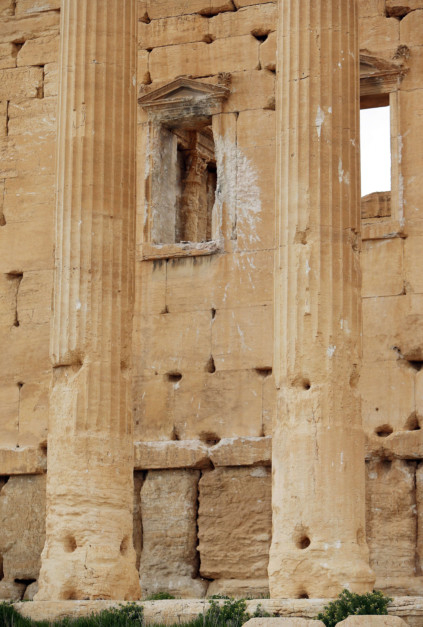
Damascus: Syrian troops pushed Daesh terrorists back from the ancient city of Palmyra on Sunday in fighting that left dozens dead and eased fears for the world heritage site.
The terrorists had seized the northern part of the modern town, Tadmur, in a major assault on Saturday but were driven out by troops and militia.
“We have good news today, we feel much better,” antiquities chief Mamoun Abdul Karim told AFP by telephone.
“There was no damage to the ruins, but this does not mean we should not be afraid.”
Provincial governor Talal Barazi told AFP that the army had recaptured northern districts of the town which the terrorists had overrun on Saturday.
“Daesh’s attack was foiled,” Barazi said.
He said the army was “still combing the streets for bombs,” but that “the situation in the city and its outskirts is good.”
The Syrian Observatory for Human Rights said there were still sporadic skirmishes but the army had reasserted its control.
“There are still clashes - though not very fierce - in the northern suburbs of Al Amiriyah,” said Observatory director Rami Abdul Rahman.
He said the terrorists were still just a kilometre away from the UNESCO-listed heritage site and its adjacent museum which houses thousands of priceless artefacts.
“Daesh is still present outside the city, to the south and east,” Abdul Rahman said.
The terrorists launched a lightning offensive across the desert last week from their stronghold in the Euphrates Valley to the east, triggering ferocious fighting with the army, which has a major base just outside the oasis town.
At least 23 regime loyalists and 29 terrorists were killed as Daesh overran northern parts of the town on Saturday, the Britain-based Observatory said.
Barazi said the army had killed “more than 130 terrorists.” He gave no figure for the army’s losses.
The governor said Tadmur’s peacetime population of 70,000 had been swamped by an influx of civilians fleeing the Daesh advance.
“We are taking all necessary precautions, and we are working on securing humanitarian aid quickly in fear of masses fleeing from the city,” Barazi said.
Abdul Karim said he remained concerned for Palmyra in light of the destruction wreaked by Daesh on pre-Islamic sites like Nimrud and Hatra in neighbouring Iraq.
The antiquities chief said he had been “living in a state of terror” that Daesh would destroy the 1st and 2nd century temples and colonnaded streets that are among Palmyra’s architectural treasures.
The terrorists tightened their control of the countryside outside Tadmur, seizing two checkpoints in the Haql Al Hail oil field, the Observatory said.
Troops and militia were fighting back in a bid to prevent Daesh from capturing the field which could offer it a significant additional source of black market revenue.
A US raid late on Friday on one of Syria’s largest oil fields left 32 Daesh members dead, including four leading officials, Abdul Rahman told AFP.
“The US operation killed 32 members of Daesh, among them four officials, including Daesh oil chief Abu Sayyaf, the deputy Daesh defence minister, and an Daesh communications official,” he said.
US officials have said “about a dozen” people were killed in the operation, which was conducted by Iraq-based US commandos in a bid to capture Abu Sayyaf.
Abdul Rahman said three of the four leading officials killed in the raid were from north Africa, but that the Daesh communications official was Syrian.
President Barack Obama personally approved the special forces operation, which was a rare use of “boots on the ground” in the US-led campaign against the terrorists that has been waged almost entirely from the air.












